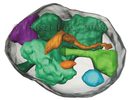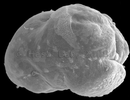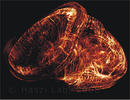Diploma Thesis
Embryonalentwicklung der europäischen Teichnapfschnecke Acroloxus lacustris (Linné, 1758)(Gastropoda, Pulmonata, Hygrophila)
Embryogenesis of the European lake limpet Acroloxus lacustris (Linné, 1758) (Gastropoda, Pulmonata, Hygrophila)
The embryonic development of the European lake limpet A. lacustris was investigated to obtain further insight into gastropod development. Basically the embryogenesis agrees with general developmental patterns of other hygrophilan Basommatophora only differing in details. The embryos of A. lacustris develop intracapsularly from trochophoral stage via a reduced "veliger" better referred to as hippo stage to an adult-like creeping stage. The whole embryonic development up to hatching of the juvenile limpets takes approximately a month (at room temperature) thus being comparatively long.
The temporal appearance of the different organs corresponds well with that found in other Basommatophora studied. A larval musculature is apparently missing, but this result requires further verification by ultrastructural analysis with striated muscles representing larval, non - striated muscles adult conditions.
Excretion first occurs via a pair of protonephridia. The adult excretory system arises from two independent anlagen, the anlage of the literal excretory system and the anlage of the pericardium. The heart appears comparatively late during embryogenesis. Up to the creeping stage the reproductive system is entirely missing.
Nerve staining reveals a spatiotemporal pattern of anti - serotonin and FMRF - amidlike immunoreactivity similar to that of other basommatophorans. Early during embryogenesis the FMRF - amidelike containing neurons appear in the posterior part of the embryos. Shortly after they are followed by the serotonin containing cells predominantly situated in the region of the future cerebral and pedal ganglia.




